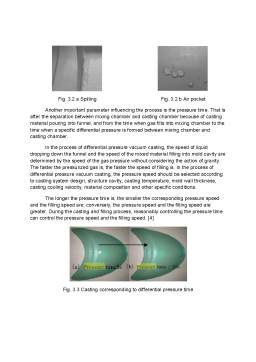Extras din proiect
I. Introduction
Vacuum casting is currently one of the most popular and flexible forms of rapid tooling for consumer products. It allows the possibility of harnessing the potential of silicone rubber moulds in the batch production, providing cheaper tools and materials. A wide range of resins (wax, plastic, metals) can be cast due to the high chemical resistance of silicone rubber and low interfacial energy of its surface. [1]
The part chosen to be produced by vacuum casting technology is a chess part and is presented in the figure below. The material for the parts is a resin SG95.
The silicon rubber used for these moulds is very advantageous for this technology. It can be easily poured around the master model to obtain a cavity.
These silicon moulds can be used to
Fig. 1.1 produce up to 20-40 plastic parts.
The process has a wide range of use from technical industry to the medical system. In the article below it is presented the use of vacuum casting technology for making a biomedical implant.
In the figure below it is presented the 3D part for which the study has been made.
Fig. 1.2.
The hip joint is basically a ball-and-socket joint. During the hip replacement surgery, the damaged hip join is replaced with metal, plastic or ceramic components. The CAD model of the component was made using Solidworks and then converted into .STL file. The master pattern of the hip joint has been produced by FDM (fused deposition modeling) followed by CVS process to enhance the surface finish. After that, multiple replicas from wax were manufactured by vacuum casting. The wax models were then assembled under the form of a tree for producing the metal parts using the vacuum casting technology.
Studies were made on the resulted metal part regarding the surface roughness and the dimensional accuracy. [2]
Fig. 1.3.
In order to prove that very fine geometrical details of the master pattern can be faithfully reproduced in the micro-mould cavities [8] via vacuum casting, in the next article the authors attempt to create both ten micro-moulds and cast micro-gears with the use of an SU8 master pattern.
Micro-moulds are generally produced by lithography methods that often use glass and silicon wafer as substrates, with the exception of the Lithographie Galvanoformung Abformung (LIGA) method, which uses metal substrate. These fabricated moulds are then integrated into the injection moulding machine for mass production. This paper presents the use of vacuum casting methods to produce
Fig. 1.4.
micromoulds instead of lithography. Silicone rubber is used as the mould material, which is capable of achieving nanometre surface finish. The master pattern of 1-mm diameter micro-gear of 60-μm teeth width and 38-μm thickness was created by standard ultraviolet (UV) lithography using SU8 photoresist. Using the vacuum casting method, ten polyurethane micro-gear specimens of 1-mm diameter and 38-μm thickness using the silicone rubber micro-moulds have been successfully cast under vacuum conditions as a demonstration. Measurement from white-light interferometry (WLI) showed that all of the micro-gear cavities in the micro-moulds were dimensionally accurate and consistent to the master micro-gear, proving that its repeatability is possible.
Bibliografie
1. “The manufacture of micromould and microparts by vacuum casting”, S. C. H. Thian & Y. Tang & W. K. Tan & J. Y. H. Fuh & Y. S. Wong & H. T. Loh & L. Lu, The International Journal of Advanced Manufacturing Technology
September 2008, Volume 38, Issue 9
2. “Dimensional accuracy and surface finish of biomedical implant fabricated as rapid investment casting for small to medium quantity production”, Jaspreet Singh, Rupinder Singh, Harwinder Singh, Journal of Manufacturing Processes, Volume 25, January 2017,
3. http://www.renishaw.com/en/5-04-plc-vacuum-casting-machine--15272
4. “Possibilities of using vacuum casting process for manufacturing cast models of turbocharger impellers”, Grzegorz Budzik, Journal of KONES Powertrain and Transport, Vol.14, No. 2 2007
5. “Analysis of vacuum casting pressure time and it’s influence on casting quality”, Nannan Xu, Zhuangya Zhang, Haiguang Zhang, Tian LV, Yuanyuan Liu, Qingxi Hu, AsiaSim 2012
Preview document
Conținut arhivă zip
- Vacuum casting technology.docx
















